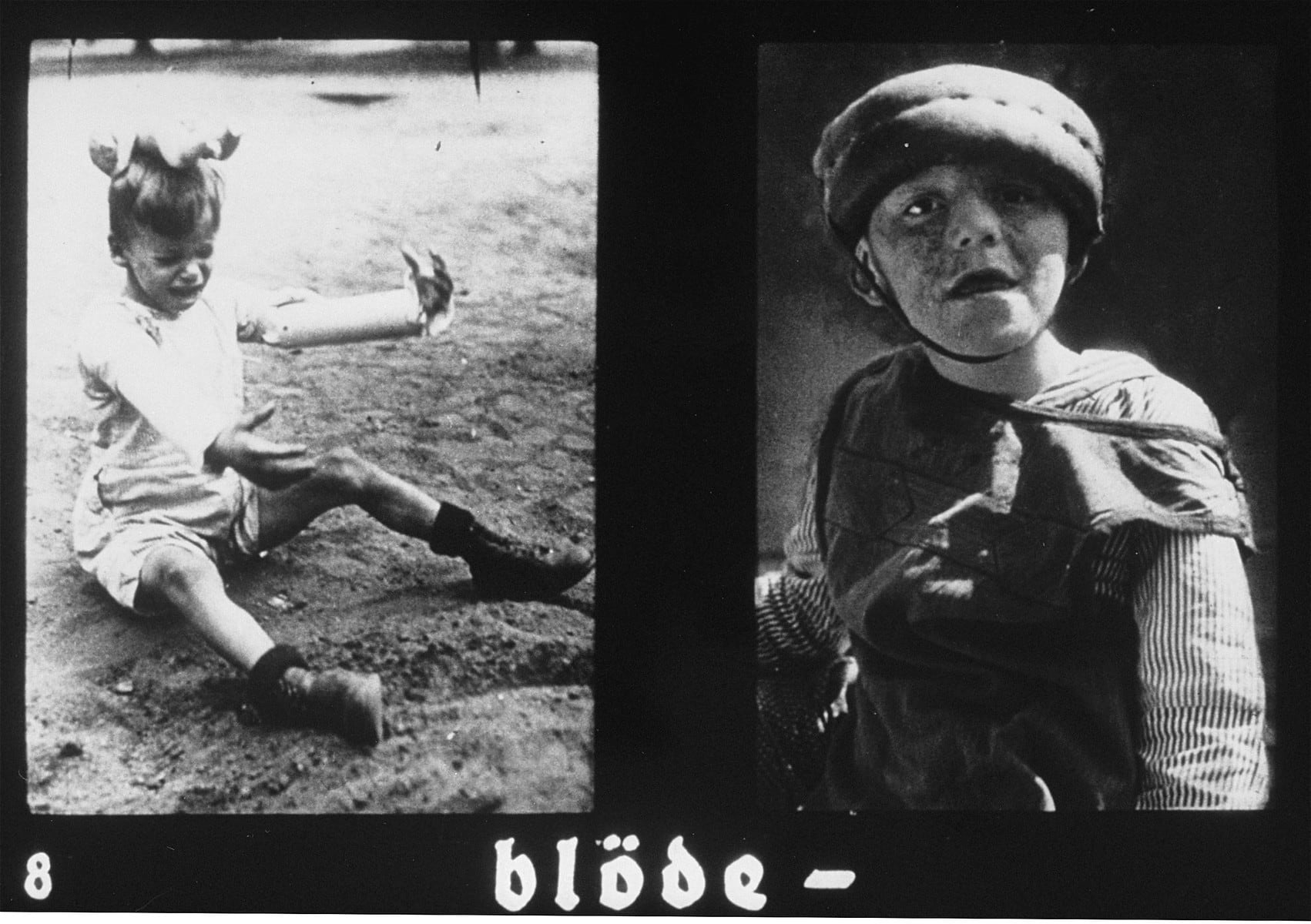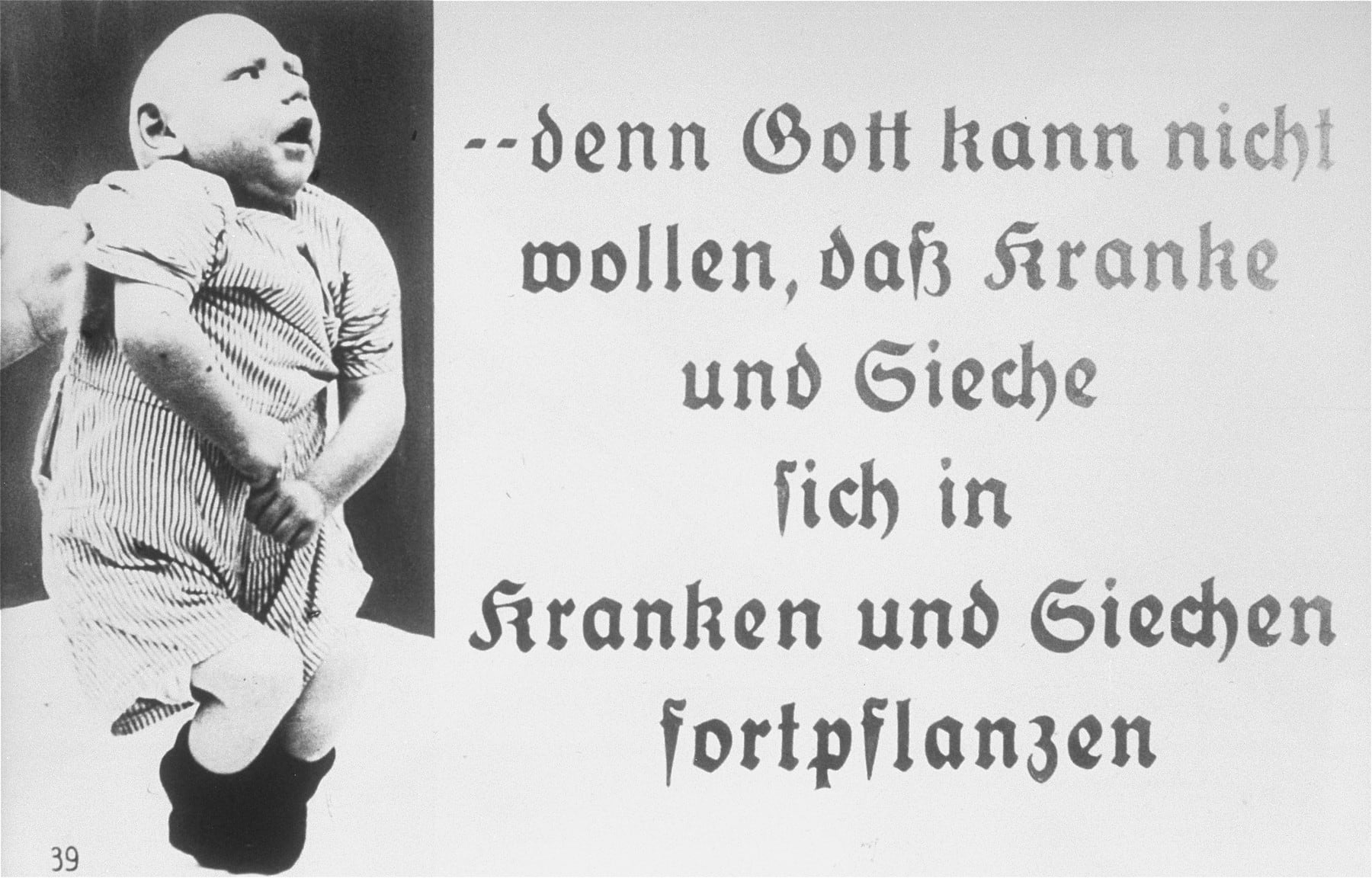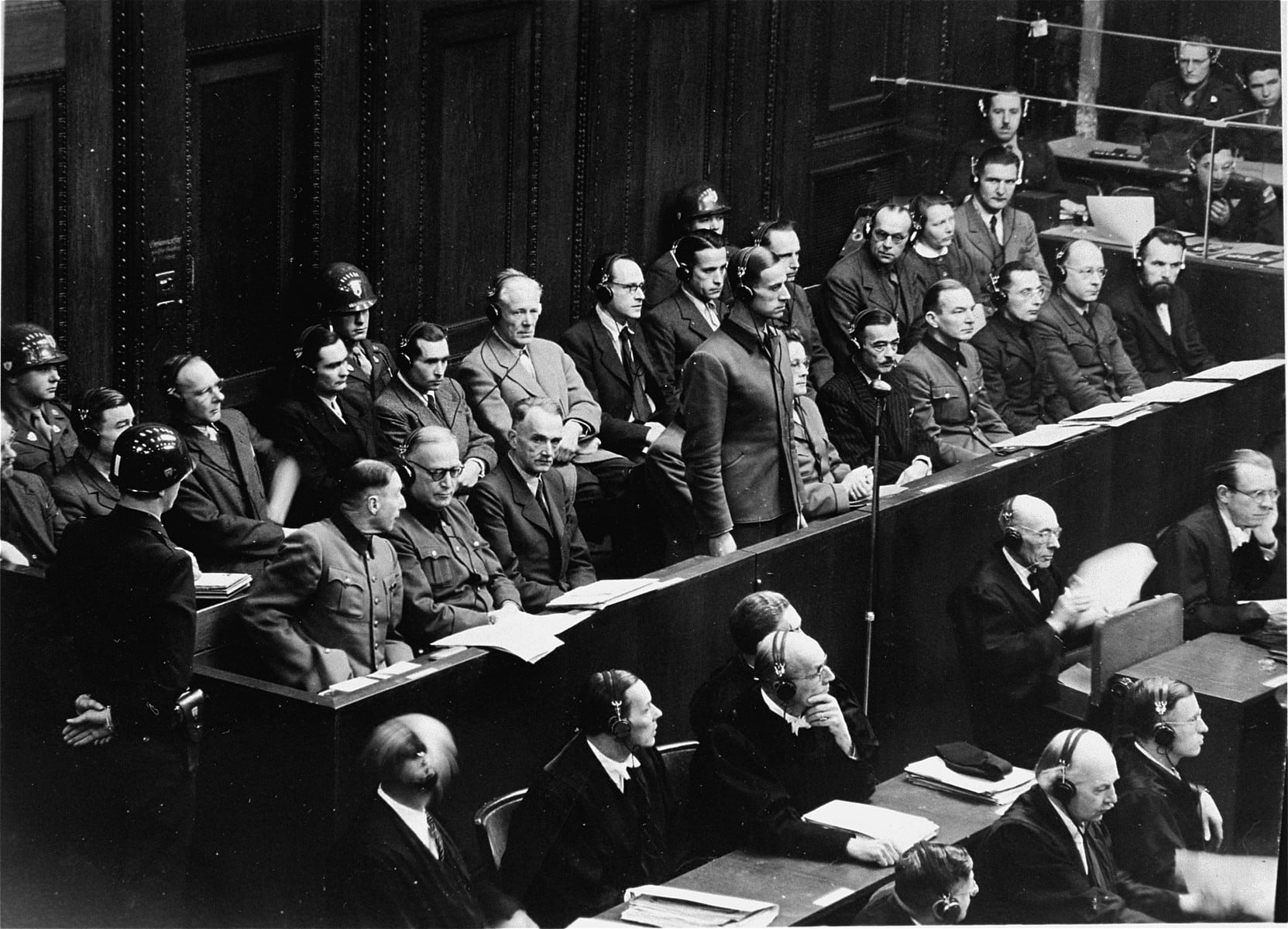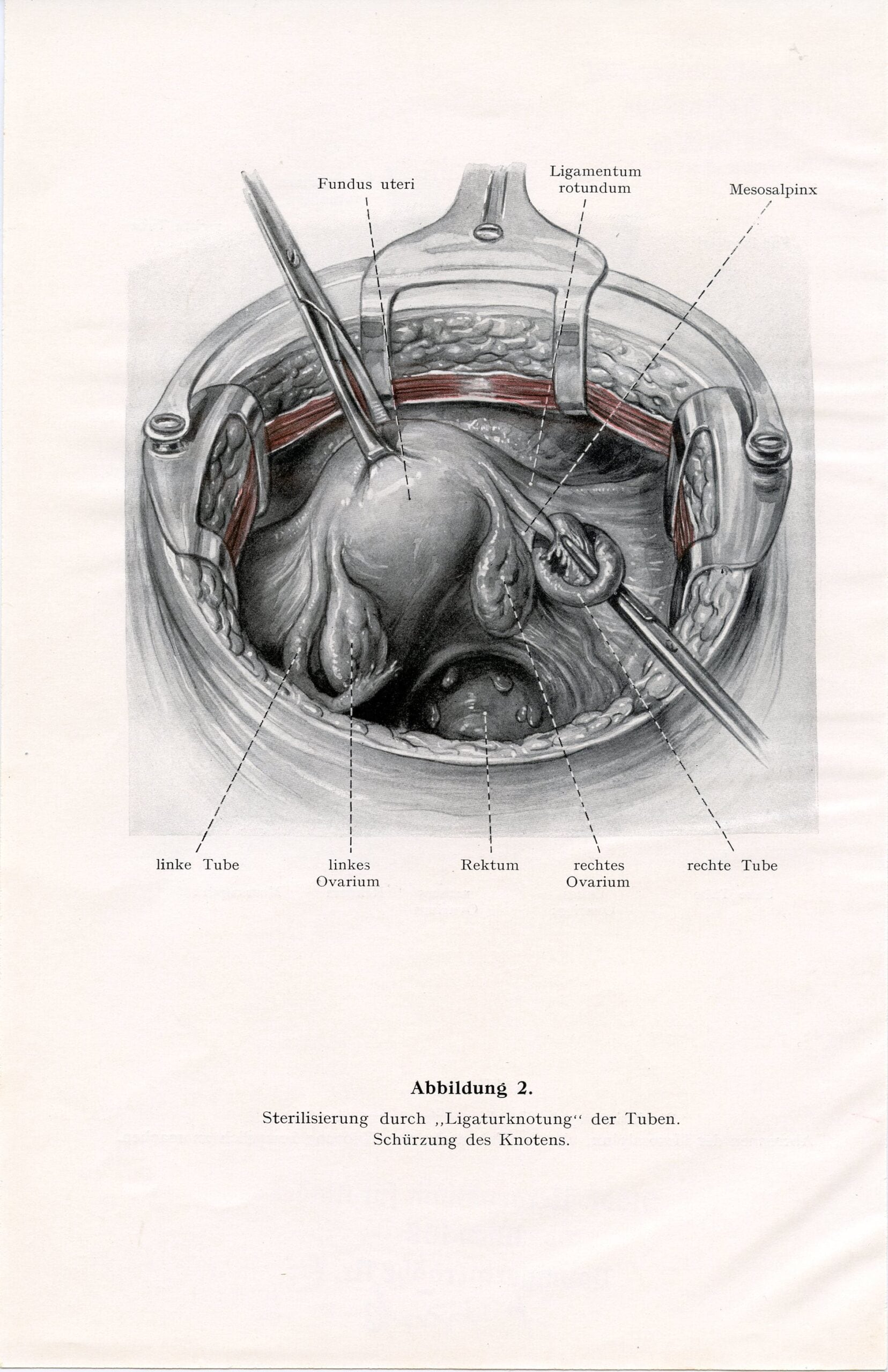
Propaganda slide. The caption reads, “Stupid.” (United States Holocaust Memorial Museum, courtesy of Marion Davy)
PART I: Diabolical Plans
This is the first part in an on-going series from the Disabled Journalists Association on eugenics. You can find the whole series here.
Note for readers: This series deals with violence against Disabled people, including murder. The stories also include references to the ableist Nazi language of the time; those terms will appear in quotation marks. Please take care when reading.
It was early 1939 — before World War II, before Adolf Hitler’s crimes against humanity were infamous — when a desperate man wrote a letter. The letter writer, ardent Nazi supporter Richard Kretschmar, had already tried and failed to convince a local doctor in Leipzig, Germany, to carry out what he wanted done. Now Kretschmar turned to the leader of the Third Reich.
Kretschmar’s Disabled infant son, Gerhard, had been born blind, with one leg, part of one arm missing, and seizures likely due to a neurological condition. (Historical sources claim Baby Gerhard was born with intellectual disabilities — or, in the ableist language of the day, “feebleminded” — but such disabilities are not diagnosable in infancy.) Kretschmar had taken Gerhard to see doctors both because of the baby’s disabilities and, writes Disability Studies scholar Mark P. Mostert, because “the child, by remaining at home, was causing his wife significant psychological and emotional stress.”
Essentially, Baby Gerhard’s mother couldn’t stand for her child to be near her — or be alive at all. The baby’s father called his son “this monster.”

Propaganda slide featuring a Disabled infant. The caption reads “… because God cannot want the sick and ailing to reproduce sick and ailing people.” (United States Holocaust Memorial Museum, courtesy of Marion Davy)
For years before Baby Gerhard’s birth, historians say, German physicians had been quietly murdering disabled newborns through “spontaneous killing” that was generally not punished. Whether Kretschmar knew this is unclear, but he had already begged pediatricians to help him by “putting it [his then 6-week-old infant] to sleep.”
At first, the doctors refused. Killing any child was against the law. But Kretschmar pushed on, writing to der Führer, asking Hitler to allow his child to be euthanized.
“Despite having tight control on government and stark, evil ambition and political drive – Hitler actually relied on senior Nazis around him to organise and orchestrate his ideas and policies,” said University College London professor and pediatrician Dr. Lee Hudson. “Hitler received a great many letters – and those around him would bring certain ones to his attention if they felt it served a particular purpose or promoted a particular agenda. The [Baby Gerhard] case is a key example of this.”
Almost immediately upon reading Kretschmar’s letter, Hitler sent Karl Brandt, one of his personal physicians, to the University of Leipzig hospital to examine Baby Gerhard. Brandt was unequivocal: the infant was a “creature” and “an idiot.” Brandt and the Leipzig pediatricians agreed. There was “no justification for keeping the child alive.”
Hitler gladly gave permission for Baby Gerhard’s “mercy death” — assuring the doctors they would face neither criminal nor legal consequences. On Tuesday, July 25, 1939, while nurses were off on a coffee break, a junior physician killed Baby Gerhard Kretschmar by lethal injection.

Karl Brandt, Hitler’s personal physician who authorized Baby Gerhard’s murder, stands in the defendants dock at the Doctors Trial at Nuremberg. (United States Holocaust Memorial Museum, courtesy of John W. Mosenthal)
And so it began. The first overtly murderous phase of Nazi eugenics was officially unleashed.
By the end of World War II, experts say, the Nazis would murder 750,000 to 1 million Disabled people across Germany and Nazi-occupied territories. It is a story few people are even aware of today.
Murdering Disabled people was the Nazi trial run for the Holocaust.
The Sterilization Campaign
Nearly 20 years before Baby Gerhard Kretschmar’s parents begged doctors to end his life, two prominent German academics wrote a text that proves how widely anti-Disabled eugenics had spread in Germany even before Hitler took power. In 1920, the same year the Nazi party was formed, retired University of Leipzig law professor Karl Binding and University of Freiburg psychiatry professor Alfred Hoche published the anti-Disabled eugenicist bible, The Permission to Destroy Life Unworthy of Life.
The book claimed killing Disabled people – “life unworthy of life” – was ethical and just because “[t]hey are a terrible, heavy burden upon their relatives and society as a whole.” The book’s message so permeated German society that by 1939, when Baby Gerhard was born, parents and relatives of Disabled people often wrote Nazi officials asking for their Disabled loved ones to be put to death in so-called “mercy killings.”

Eugenics propaganda plate used to indoctrinate school children with Nazi theories of “race science,” entitled Eradication of the Sick and Weak in Nature. The lower caption reads “That which does not satisfy the demands of existence is crushed.” In Nazi Germany, the teaching of eugenics and racial biology began in primary school. (United States Holocaust Memorial Museum, courtesy of Hans Pauli)
Yet Hitler’s anti-Disabled hatred long predated the book. Hitler had for decades been enamored of eugenics, the white supremacist study and practice, widely discredited as unscientific, of creating an optimal human population without so-called defects like Disability, Black or brown skin, or sexual or gender diversity. (We’ll tell you much more about where Hitler got his inspiration in a later part in this series.) In 1925, in Mein Kampf, Hitler wrote: “[The state] has to take care that only the healthy produce children… It has to declare anyone who is visibly ill and has inherited a disease as unfit for procreation and it has to carry this out in practice.”
In order to realize his eugenicist master plan, Hitler deployed murderous actions against Disabled people in phases.
After becoming Germany’s chancellor in 1933, it took Hitler less than six months to pass a forced sterilization law, ostensibly to halt what he called the contamination of the German nation by inferior people. The Law for the Prevention of Genetically Diseased Offspring laid out nine supposedly genetic conditions that would require sterilization (including deafness and chronic alcoholism). Health professionals were forced to report Disabled adults to the government for sterilization.

A black and white Nazi-era pamphlet describing the sterilization procedure for people assigned female at birth. (Kenyon College)
For many, the sterilization was done without victims’ knowledge: In what was called the counter program, Disabled people were summoned to complete forms while standing at a counter; on the other side of the counter, X-ray radiation was pointed at their genitals for two to three minutes — rendering them infertile. Many Disabled people suffered horrific burns after subjection to the counter program; many others were harmed after chemicals were injected into their reproductive tracts in botched sterilizations.
All told, including Roma, mixed-race people, and people of African and Asian descent — those also deemed unfit to reproduce — the Nazis forcibly sterilized an estimated 400,000 people. More than 5,000 of them died.
German gynecologists also forced an estimated 50,000 more women to have so-called eugenically directed abortions.
With the sterilization program in full swing, the Nazis would soon take their next step: Eliminate living Disabled children, with Baby Gerhard’s murder paving the way.
Ausschusskinder: “Garbage Children”
In late-1930s Germany, public messaging focused on the health and vitality of the German people. If the people, the Volk, were to remain healthy and strong, it would require what Nazi officials called purification to alleviate the “burden” of Disabled people on society.
The Ministry of Public Enlightenment and Propaganda spread eugenics thinking everywhere. At high schools, teachers assigned students to calculate better uses for government funding than keeping alive the country’s Disabled people — who, in Nazi parlance, were called “useless eaters.”

Nazi propaganda showing four Disabled men, with caption reading: “Hereditary illnesses are a heavy burden for the people and the state.” (United States Holocaust Memorial Museum, courtesy of G. Howard Tellier)
These propaganda messages were omnipresent: At movie theaters before the feature, propaganda documentaries promoted the eugenicist belief that Disabled “marginal human beings” could bring about death to the Volk. In bookstores, a popular novel romanticized “euthanasia” through the story of a beautiful young pianist with multiple sclerosis who convinces her physician husband to kill her. The goal of this campaign was to acclimate Germans to the idea that Disabled people were not only disposable, but also hurting their nation.
“Attempting to develop a culture of acceptability for the murder of people, in particular children, with Disabilities was an initial step for defending a similar approach to Jewish people and children in the Holocaust,” said Dr. Hudson of University College London.
Amidst this environment, Baby Gerhard’s secret and successful killing showed Hitler that the scene had been set to implement the next phase of his anti-Disabled eugenics plan.
Hitler organized the Reich Committee for the Scientific Registration of Serious Hereditary and Congenital Diseases, calling again on physician Karl Brandt (who rubber-stamped Baby Gerhard’s killing), and chancellery chief Philip Bouhler, to secretly develop a program of Kindereuthanasie, the “euthanasia” of Disabled children, or Ausschusskinder: “garbage children.”
The Kindereuthanasie program was designed to be free of Hitler’s fingerprints. On August 18, 1939, a decree was issued requiring hospitals, physicians and midwives to report all so-called defective children from birth to age three to the government, for a payment of 2 reichsmark per report – around $36 in today’s U.S. currency. However, if a health professional failed to report a child, they would be fined 150 reichsmark (nearly $2,700 today) or sentenced to four weeks in jail.

Richard Jenne, the last child killed by the head nurse at the Kaufbeuren-Irsee killing center. (United States Holocaust Memorial Museum, Courtesy of National Archives and Records Administration, College Park)
The timing of this children’s euthanasia program was anything but coincidental. Hitler had planned since at least 1935 that an outbreak of war would be a perfect pretext for ushering in a eugenics killing program. On Sept. 1, 1939, exactly two weeks after the Kindereuthanasie decree became law, Germany invaded Poland.
World War II had begun.
In the coming weeks, the Disabled Journalists Association will bring you more reporting on eugenics – in history and contemporary society – as part of this series. Stay tuned.
More DJA Coverage
Kara McCurdy Prior to New York Assemblyman Zohran Mamdani’s win in New York City’s Democratic primary, there were questions...
By
November 3, 2025
As a Disability-led organization, we think it’s important to share the wealth. Here are five newsletters that we...
By
October 16, 2025
Aaron Kittredge via Pexels Donald Trump’s onslaught of cuts to federal services is now being directed at...
By
October 13, 2025


